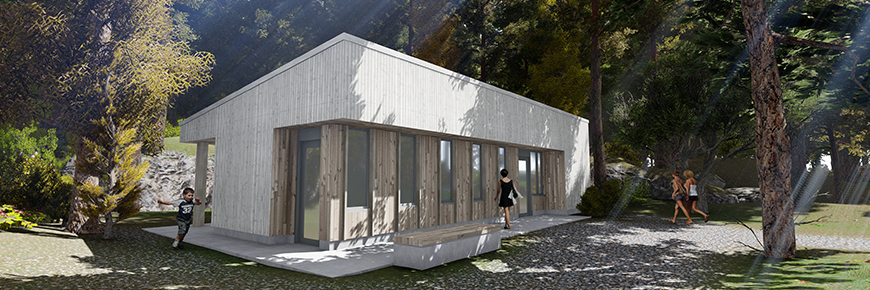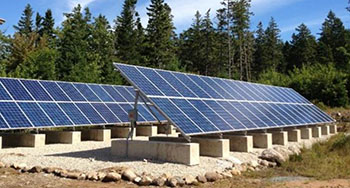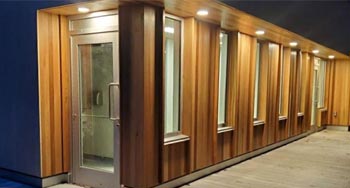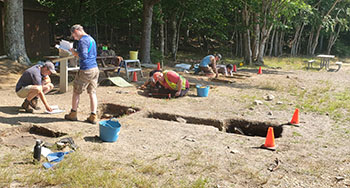
Infrastructure projects
Kejimkujik National Park and National Historic Site
Parks Canada invested $3 billion to rehabilitate infrastructure assets within national historic sites, national parks, and national marine conservation areas across Canada. This historic five-year investment (2017-22) supports conservation while promoting visitor experience by creating safe welcoming spaces for diverse visitor groups to use and enjoy.
Climate change impacts to Parks Canada administered places are complex and the Agency is committed to integrating climate change mitigation and adaptation actions into its work.
Current projects
Work is ongoing to protect resources and make visitor infrastructure improvements at Kejimkujik.
Investments in Parks Canada’s infrastructure ensure safe, high-quality, and meaningful experiences for visitors, enabling Canadians to discover nature and connect with history, while supporting local economies and contributing to growth in the tourism sector.
Completed projects
Wildfire Risk Reduction (WRR) project
Completed: November 2023
Parks Canada is reducing the risk of wildfire and improving fire response by:
- clearing vegetation in a 30-metre zone around the buildings near the main entrance; and
- testing the feasibility of re-opening a section of the 5-metre boundary line to provide access to a water source (Round Lake), as well as serve as a fuel break.
The projects focus mainly on clearing the vegetation surrounding site buildings following techniques of the national FireSmart Canada program for increasing neighbourhood resilience to wildfire across Canada.
Kejimkujik Seaside trail rehabilitation
Completed: Spring 2022
Repairing and realigning Kejimkujik’s Seaside trail network will ensure better resilience against washout and erosion events through its design, with sustainable trails routed away from areas that are vulnerable to coastal erosion.
Damage to both the Harbour Rocks Trail and the Port Joli Head Trail from Hurricane Dorian (2019) included coastal erosion and trail undercutting, washouts, strewn boulders, and loss of headland surface.
What changes will visitors see at Kejimkujik Seaside?
Visitors will be treated to new vistas, particularly overlooking Port Joli Bay from Boyd’s Cove, and looking down over the string of white sandy beaches of St. Catherines River Bay on the approach to Harbour Rocks Beach.
At a design level, the trail rehabilitation improves climate adaptability, as well as increased visitor and animal safety by considering:
- alignment that avoids areas along coastal edges that are susceptible to erosion
- alignment that avoids steep or wet areas
- building features like rock crossings, rolling grade dips, proper bench cuts, and raised tread, to encourage optimal drainage and re-route water away from trail surface
- alignment that avoids black bear feeding habitat
- alignment that avoids lengthy stretches of cobble stone beach
Parks Canada’s first net-zero campground
Completed: Spring 2022
The installation of a photovoltaic solar array at Kejimkujik marks a critical step in reducing greenhouse gas (GHG) emissions by achieving a 100% offset of average monthly power consumption in the park’s campground, including 200 electrified campsites, 10 washroom and shower buildings, a water treatment plant, sewage lift stations and service buildings.
Completed in the spring of 2022, the system generates 12,000 KW hours of renewable energy per month, which will be used to offset general power usage for the park outside of the main visitor season.
The solar array reduces Kejimkujik’s total GHG emissions by around 17% (96 tonnes/year). Over the lifespan of the project, it is expected to reduce GHG emissions by 3,000 tonnes – equivalent to taking 1,035 cars off the road for one year.
Mill Falls pedestrian bridge
Completed: Fall 2021
Parks Canada replaced the floating pedestrian bridge at the Mill Falls day-use area with a new climate-resilient permanent pedestrian bridge.
The new bridge features technology and abutment designs that take into account climate change adaptation planning, and are able to withstand dramatic changes in storm water flow as well as wind loading.
The installation of the permanent Mill Falls pedestrian bridge will allow for more dependable four-season access to several trails, including the new Ukme’k shared-use trail.
Jeremy's Bay Campground
The Government of Canada has invested over $10 million for improvements to visitor facilities at Kejimkujik National Park and National Historic Site to create a modern, safe and inclusive experience for visitors to Kejimkujik.
Highlights of improvements include:
New washroom and shower facilities
Ten new inclusive washroom and shower facilities across Jeremy’s Bay Campground provide a modern and safe experience for visitors to Kejimkujik.
The new design has a common hallway space for all users with five individual rooms, each with toilet, sink, and grooming area behind a lockable door as well as three shower rooms with lockable doors. Accessible/family options exist for both toilet rooms and shower rooms, with features such as push-button door, handrails, benches, variable-height shower heads, baby change table, and one adult change table.
New and efficient water treatment and wastewater treatment facilities
The completed work included refitting the campground’s underground wastewater management utilities and building a new water treatment facility to bring these systems up to the required standards.
Accommodations
Five new Ôasis units add to the accommodations at Jim Charles Point. Perched in the trees overlooking Kedge Beach, these heated teardrop-shaped units on stilts will appeal to new audiences. This new offer continues the diversification of Kejimkujik’s accommodations, joining the heated and newly insulated oTENTik village and rustic cabins at Jim Charles Point. The Yurt located at Jake's Landing remains part of the offer. For the prepared visitor, these new accommodations will warm shoulder season stays. Visitors are encouraged to bring warm clothing and sleeping bags during shoulder season stays.
New shared-use trail
Kejimkujik’s first new trail in decades connects day-use areas and the campground on a single shared-use trail. The project includes enhancements and upgrades to existing trails, as well as the addition of new trail that includes optional mountain biking features (like natural features that can be easily bypassed, rollers, berms, and rock crossings).
The name of the trail - Ukme’k (pronounced “ook-may-k”) means “twisted” in Mi’kmaq, inspired by the path the trail takes as it follows the Mersey River. Ukme’k presents visitors an opportunity to interact with the Mi’kmaw cultural landscape along an historic and culturally significant river.
Related archeological work
As the only national park that is also a national historic site, recognizing the Mi’kmaw cultural landscape across the entire site, archaeological work is a critical first step in the construction process. Before construction work began, archeologists investigated the area using a series of test pits to search for the presence of cultural resources and historical artifacts that, when found, were recovered and preserved.
Over the course of the past five years of infrastructure projects at Kejimkujik, Parks Canada and the Mi’kmaq of Nova Scotia, as represented by the Kwilmu'kw Maw-klusuaqn Negotiation Office (KMKNO), have developed and implemented a collaborative archaeology model. The completed archeology work for the new facilities in Jeremy’s Bay Campground provided an opportunity to strengthen and expand this collaborative archeology model. Participatory archaeological work with the active participation of KMKNO and First Nations communities has strengthened the relationship between the Parks Canada and the Mi’kmaq.
The lessons gained from archaeology are not only important for conservation, but also for protection and presentation. Archaeological sites and the artifacts recovered help us to better understand these locations, their history and the people that lived and worked there, which in turn informs the interpretation of the area for visitors.
- Date modified :


